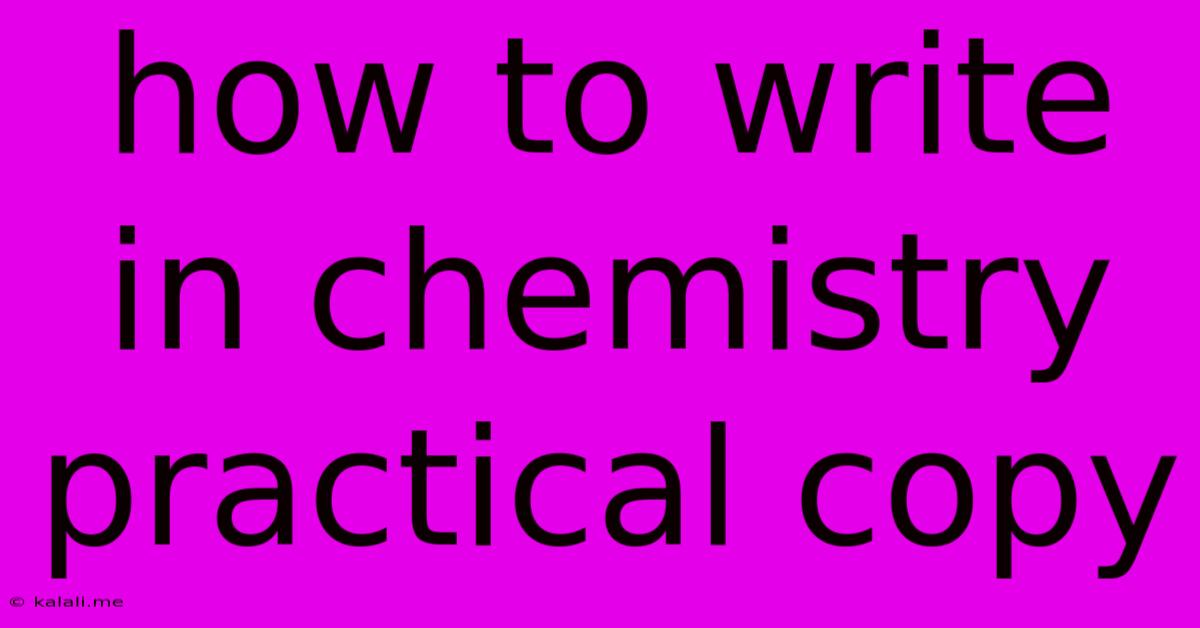How To Write In Chemistry Practical Copy
Kalali
Jun 12, 2025 · 3 min read

Table of Contents
How to Write a Chemistry Practical Report That Impresses
Writing a compelling chemistry practical report is crucial for demonstrating your understanding of experimental procedures, data analysis, and scientific communication. This guide will walk you through the essential components of a high-scoring report, ensuring your hard work shines through. This isn't just about getting a good grade; it's about developing vital skills for any future scientific endeavors.
Understanding the Purpose: More Than Just Recording Data
Your chemistry practical report isn't simply a record of what you did in the lab. It's a scientific document that communicates your experimental process, findings, and conclusions in a clear, concise, and reproducible manner. Think of it as a story about your experiment, meticulously documented and analyzed. This is why mastering the art of writing a good practical report is so crucial.
Key Components of a High-Quality Chemistry Practical Report:
1. Title: Clear and Concise
Your title should accurately reflect the experiment's focus. Avoid ambiguity. A good title should immediately communicate the experiment's core objective. For example, instead of "Experiment 1," use "Determination of the Molar Mass of an Unknown Volatile Liquid Using the Dumas Method."
2. Abstract: A Concise Summary
The abstract is a brief overview (typically 150-250 words) summarizing the entire report. It should include the experiment's objective, methodology, key findings, and conclusions. Think of it as a mini-version of your entire report. This section is crucial; it's often the first—and sometimes only—part that readers will examine.
3. Introduction: Setting the Stage
The introduction provides background information on the experiment's theoretical basis. Clearly state the experiment's aim and its relevance. Briefly discuss any relevant chemical principles or equations. This section demonstrates your understanding of the underlying scientific concepts.
4. Materials and Methods: Reproducibility is Key
This section meticulously details the materials used and the procedures followed. Include sufficient detail for another scientist to replicate your experiment. Use precise measurements and avoid vague descriptions. Include diagrams if necessary to clarify the experimental setup. This section is all about ensuring repeatability – a cornerstone of scientific methodology.
5. Results: Presenting Your Data
Present your experimental data clearly and concisely using tables and graphs. Avoid including raw data unless specifically requested. Focus on presenting processed data, calculations, and key observations. Appropriate use of tables and graphs is essential for clear data presentation. Ensure all tables and graphs are properly labeled and captioned.
6. Discussion: Interpreting Your Findings
This is where you analyze your results and interpret their significance. Discuss sources of error, limitations of the experimental method, and potential improvements. Compare your results with theoretical values or expected outcomes. This section showcases your analytical skills and critical thinking abilities. Addressing limitations and potential errors honestly builds credibility.
7. Conclusion: Summarizing Your Key Findings
Summarize your main findings and conclusions concisely. State whether your hypothesis was supported by the experimental data. Avoid introducing new information here; instead, reiterate the key takeaways from the discussion section.
8. References: Giving Credit Where Credit is Due
Properly cite all sources using a consistent citation style (e.g., APA, MLA). This demonstrates academic integrity and allows readers to verify your information.
Tips for Success:
- Use precise language: Avoid vague terms and use scientific terminology accurately.
- Maintain objectivity: Present your data without bias or subjective interpretation.
- Proofread carefully: Errors in grammar and spelling detract from the credibility of your report.
- Seek feedback: Ask a peer or instructor to review your report before submission.
By following these guidelines and paying close attention to detail, you can craft a chemistry practical report that effectively communicates your understanding of the experiment and showcases your scientific skills. Remember, a well-written report is a testament to your scientific rigor and analytical capabilities.
Latest Posts
Latest Posts
-
Wireless Internet Is An Example Of Telecommunications True False
Jun 13, 2025
-
Is Ifsc Code Same As Swift Code
Jun 13, 2025
-
Measure The Force Of Gravity Acting On An Object
Jun 13, 2025
-
Authorization Letter To Pick Up Documents
Jun 13, 2025
-
Who Is Written By Bhagavad Gita
Jun 13, 2025
Related Post
Thank you for visiting our website which covers about How To Write In Chemistry Practical Copy . We hope the information provided has been useful to you. Feel free to contact us if you have any questions or need further assistance. See you next time and don't miss to bookmark.